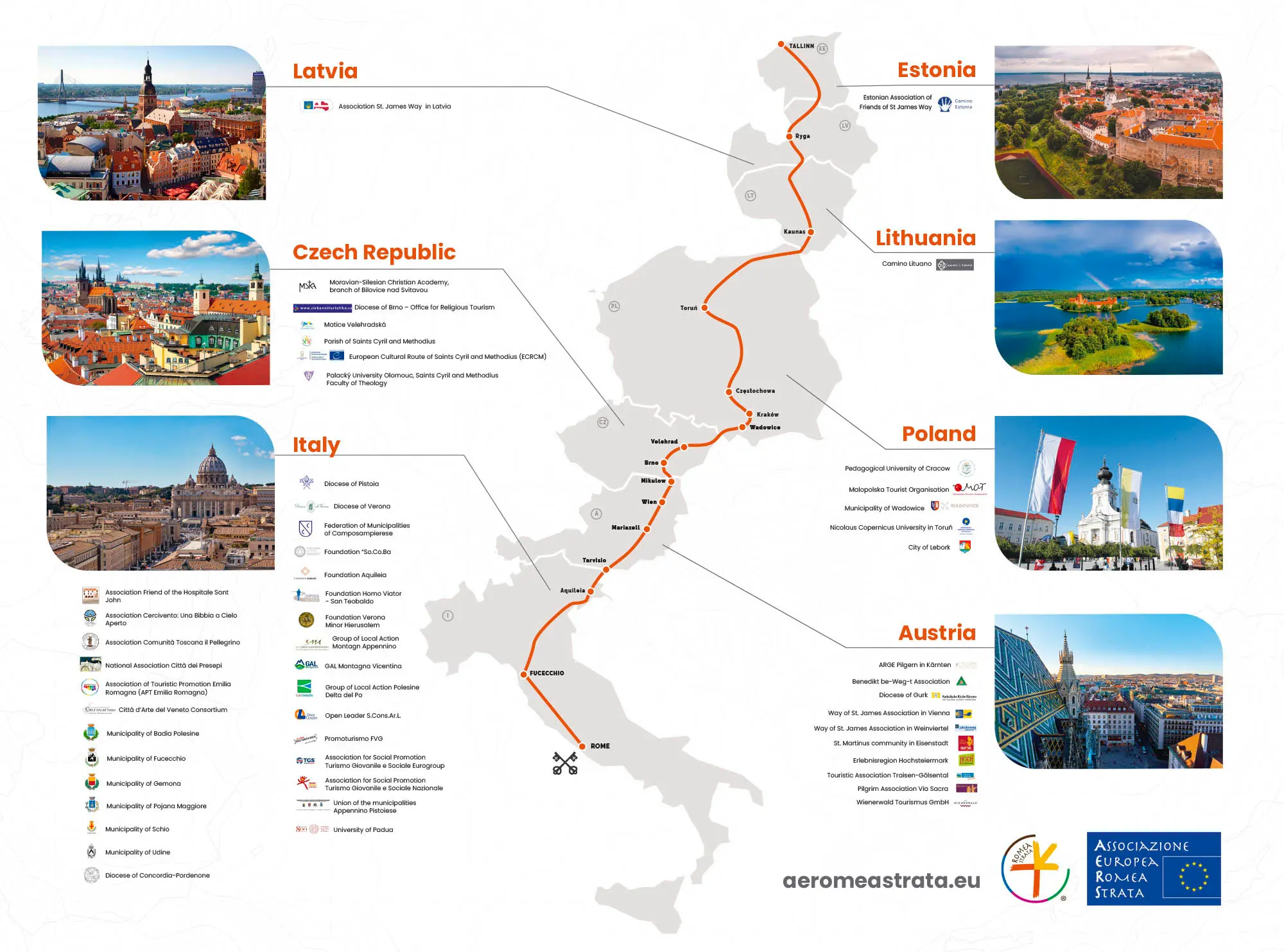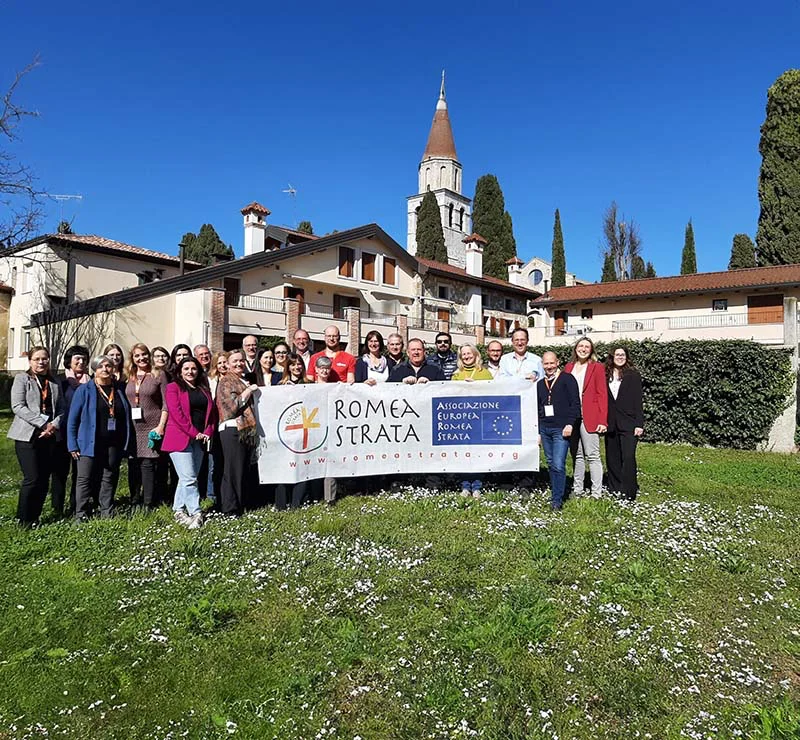The Romea Strata is a cultural route of the council of Europe

The recognition celebrates shared European heritage and strengthens bridges between nations in accordance with the certification criteria contained in Resolution CM/Res (2023)2 of the Committee of Ministers of the Council of Europe. Image: AERS.
The Governing Board of the Enlarged Partial Agreement on Cultural Routes of the Council of Europe in Luxembourg has officially certified the Romea Strata, the longest path to Rome, as a Cultural Route of the Council of Europe. Estonia, Latvia, Lithuania, Poland, Czech Republic, Austria, and Italy are the countries crossed by what was once a bustling trade route leading to the Holy City. Today, the path unveils layers of history, culture, religious faiths, and knowledge, inviting discovery on foot, step by step.
This prestigious recognition underscores the value of shared European heritage and the itinerary’s fundamental role in providing an extraordinary opportunity to foster mutual cultural understanding and knowledge. The certification strengthens initiatives supporting the sustainable development of local communities, the valorization of lesser-known tourist destinations, and promotes the local management of cultural sites.
Initiatives such as the SmartAltopiano Living Lab on tourism in Veneto (Italy) and the local participatory workshops in Małopolska (Poland) are good practices that, thanks to this certification, can be expanded and replicated along the itinerary, consolidating Romea Strata as a catalyst for cultural promotion and sustainable development, with a positive impact on the environment and communities.
The Rationale
The Council of Europe has certified the Romea Strata because it represents a bridge connecting different yet interconnected countries through paths of spirituality, history, and trade, thereby stimulating cooperation among the territories it traverses. The itinerary, in fact, enhances European memory, history, and heritage, linking various states, promoting common values, intercultural dialogue, and sustainable cultural tourism.
A Constantly Expanding Network
The strength of the Romea Strata lies in the diversity of its network, designed to activate and manage the itinerary effectively at local, regional, and international levels. The Romea Strata European Association currently counts 60 members – with 4 new members in 2024 – including public administrations, non-profit organizations, universities, small and medium-sized enterprises, and religious bodies. Expansion continues with 8 potential new members on the horizon.

Members of the Associazione Europea Romea Strata (AERS). Photo: AERS.
Activities in Line with European Priorities
Thanks to the work of its members, the Romea Strata European Association implements initiatives across the 5 priority fields of action established by the Council of Europe for Cultural Routes:
- Research and Development: Members actively participate in and promote conferences, seminars, and public presentations. The Association promotes an annual General Assembly, the activities of the Scientific Committee, and a constant dissemination of good practices.
- Enhancement of European Memory, History, and Heritage: The flagship events, organized twice a year on different themes – peace and environmental sustainability – are the most popular both in terms of the number of initiatives along the itinerary and people involved. The network also supports free events and group experiences to raise awareness of the Romea Strata’s heritage, especially when little known or located in rural areas, which would otherwise be difficult to promote independently.
- Cultural and Educational Exchanges for Young Europeans: Established activities such as those of the “Network of High Schools for Slow Tourism” and recent proposals like an Erasmus+ project involving Austria and Italy, offer young people the opportunity to connect with the itinerary.
- Contemporary Cultural and Artistic Practices: Network members actively participate in photographic exhibitions and promote competitions among students and for civil society, also creating opportunities for artistic companies performing in relays along segments of the itinerary.
- Cultural Tourism and Sustainable Cultural Development: Over the last three years, familiarization trips for tourism professionals and press tours dedicated to journalists have been organized. An increasing number of tour operators are creating travel packages along the Romea Strata.
The Advantages of Certification
Certification as a Cultural Route of the Council of Europe represents a quality guarantee recognized throughout Europe by visitors, tourism operators, and public authorities. This recognition offers greater national and international visibility, access to a vast network of partners and experts in heritage management, opportunities for skills development, networking with other European entities, and increased access to funding.
Statement by Romea Strata European Association President
Don Raimondo Sinibaldi, President of the Romea Strata European Association, stated: “Today we celebrate an extraordinary recognition: the Council of Europe has certified the Romea Strata as a European Cultural Route. This achievement represents a tangible testament to how people can unite through common culture and history, overcoming the divisions that too often characterize our time. In an era marked by conflicts and international tensions, the Romea Strata aims to be a living testament to reconciliation. I wish to thank all 60 members of our Association who, across seven countries, have worked tirelessly for this goal. This certification is not an endpoint, but a starting point for building ever new opportunities for mutual understanding and promoting a common European sentiment through shared cultural heritage”.